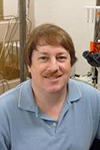Areas of Excellence
GPCR Signaling
 David I. Yule, Ph.D.
David I. Yule, Ph.D.
GPCRs constitute the largest family of cell surface receptors in the human genome and are the largest single class of targets for human therapeutics. Research in the area of G protein-coupled receptors (GPCRs) has exploded in the last 5-10 years culminating in the awarding of the 2012 Nobel Prize in Chemistry for GPCR research to Brian Kobilka and Robert Lefkowitz. Analysis and manipulation of GPCRs and the signal transduction networks that they activate has impact on all aspects of physiology and human disease including cardiovascular disease, cancer, diabetes, stem cell biology, and immunology; all of which are primary strengths at the University of Rochester. Approaches to GPCR signaling biology also encompass a broad range of scientific disciplines that range from whole animal approaches, single molecule spectroscopy and imaging, proteomic analysis, structural biology and the detailed molecular dissection of signaling pathways relevant to human disease.
Specific Areas of Focus
- Analysis and of GPCR-dependent signaling pathways in pathological states with a goal to identify novel therapeutic targets and approaches.
- Development of small molecule therapeutics targeting GPCR signaling for treatment of pain, autoimmune diseases, cancer and heart failure.
- Detailed molecular analysis of GPCR signaling mechanisms.
Ion Channels
 Robert T. Dirksen, Ph.D.
Robert T. Dirksen, Ph.D.
Ion channels are expressed in every cell in the body and are among the most targeted proteins in clinical therapeutics. Ion channel defects underlie a multitude of debilitating diseases, including cardiac arrhythmias, heart failure, myasthenia, myotonia, epilepsy, ataxia, cystic fibrosis and diabetes. This group is working to unravel the molecular details that determine ion channel function, the mechanisms by which ion channel defects lead to human disease and apply this information toward the development of novel drug interventions.
Specific Areas of Focus
- Ion channel structure, function and regulation
- Mechanisms of cardiac arrhythmias and heart failure
- Pathophysiology and treatment of disorders of muscle excitability
- Modulation of intracellular calcium signals
- Control of neurotransmitter release and protein/fluid secretion
Cell Adhesion Molecules
 Denise C. Hocking, Ph.D.
Denise C. Hocking, Ph.D.
In order to form functional tissues, cells must adhere to and communicate with each other and the surrounding extracellular matrix (ECM). Defects in these communication processes underlie key aspects of many diseases, including peripheral vascular disease, atherosclerosis, fibrosis, stroke, diabetes, inflammatory bowel disease and cancer. This group investigates these molecules and processes to engineer tissues, to identify predictive tools for focused therapeutic targeting, and to develop novel methods to analyze tissue and organ function.
Specific Areas of Focus
- How ECM proteins signal the development and function of vascular beds
- How adhesion molecule dysregulation contributes to disease processes
- How communication between different cell types controls integrated tissue and organ function
- How integrated signaling can be used to identify new drug targets